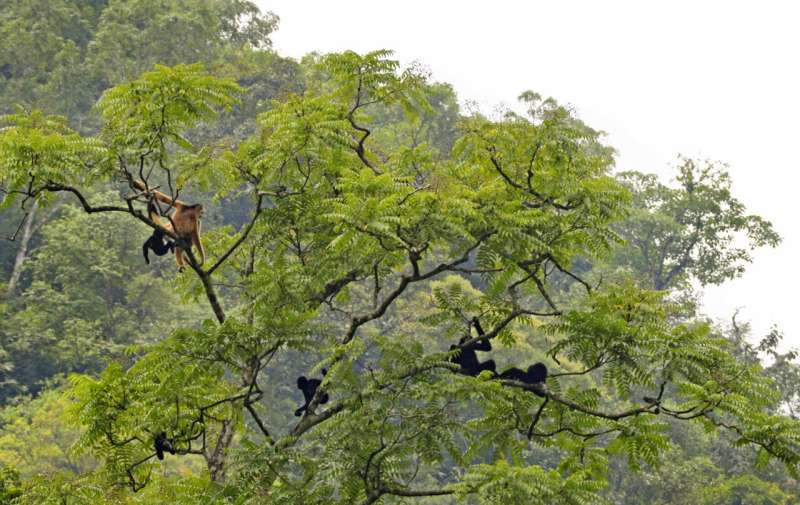This article has been reviewed according to Science X's editorial process and policies. Editors have highlighted the following attributes while ensuring the content's credibility:
fact-checked
peer-reviewed publication
trusted source
proofread
A primate on the brink: Cao vit gibbon even closer to extinction than feared

Thanks to new technology, we now have a better idea of just how vanishingly rare the world's second rarest ape really is.
The population of the critically endangered cao vit gibbon, confined to a small forest fragment on the Vietnam-China border, is now estimated to comprise a mere 74 individuals in just 11 family groups. This figure is 38% lower than the previous estimate of 120 individuals.
In collaboration with local partners, Fauna & Flora's conservation team in Vietnam conducted the latest population survey using a combination of advanced monitoring techniques to ensure more accurate results than traditional monitoring methods can typically hope to achieve. Their results are published in Scientific Reports.
Listening to local voices
For the first time, the survey team applied the "vocal fingerprinting" technique, where acoustic recorders are used to listen to gibbon songs and identify individual voices.
As with humans, each gibbon's singing voice seems to be unique to a specific individual—with the male song particularly distinctive. Survey teams monitored almost 30 listening posts from one hour before sunrise until late morning. Where gibbons are concerned, the early bird catches the earworm, because these highly vocal apes are usually the ones kickstarting the dawn chorus in their forest haven.
Revised head count
The gibbon count was also assisted by drones mounted with thermal imaging cameras, which enabled the team to pinpoint particular groups more easily and count the number of individuals in them more accurately.
The cao vit gibbon is one of the world's rarest primates, thought to be extinct until it was rediscovered by Fauna & Flora in 2002. Accurate monitoring of the last remaining population is critical to the species' survival, but traditional ground-based monitoring methods, such as using binoculars and cameras, are tricky in this steep, almost inaccessible, terrain and can be unreliable as the gibbons move rapidly through dense forest canopy.
What do these results mean?
The good news is that, despite the revised estimate, there is no evidence that the cao vit gibbon population has declined. Thanks to the vital work of Fauna & Flora and our partners since this elusive ape's rediscovery, gibbon numbers are still thought to be increasing, with the number of individuals in long-term monitored groups on the rise, and new groups having formed in recent years. The difference is due to accidental double-counting in previous surveys that used traditional species monitoring techniques.
The new and more accurate population estimate serves as a more robust basis for informing conservation management actions and tracking success over time. However, the cao vit gibbon is evidently in much more immediate danger from the threats posed by small population size than previously thought. These include loss of genetic diversity, inbreeding and vulnerability to unforeseen catastrophes. Conservation action, particularly habitat restoration to broaden the cao vit gibbon's extremely limited range, is now more urgently needed than ever.
Project lead, Oliver Wearn, states, "Cao vit gibbons are loud and lively singers. They defend their territories mainly by singing, and their calls can be heard from a kilometer or more away. Our community monitoring teams told us that each male adult gibbon has its own unique voice, just like we do, and so for this project we decided to take advantage of that.
"Thanks to this idea of 'vocal fingerprinting,' we have been able to create a much more accurate picture of the size of the population, and where the territories of each group are. This new method is not only more accurate, but is non-invasive, enabling us to study the gibbons without disturbing their natural behavior."
Taking action to save the cao vit gibbon
Conservation measures to protect the cao vit gibbon have been in place since it was rediscovered in 2002 in Vietnam and re-confirmed in China in 2006. These include the establishment of two protected areas; regular patrolling by rangers and community groups to protect against poaching; long-term monitoring and research; habitat restoration; support for sustainable livelihoods; transboundary conservation cooperation; awareness-raising about the plight of the gibbon, and educational events with local schools and communities.
More information: Oliver R. Wearn et al, Vocal fingerprinting reveals a substantially smaller global population of the Critically Endangered cao vit gibbon (Nomascus nasutus) than previously thought, Scientific Reports (2024). DOI: 10.1038/s41598-023-50838-2
Journal information: Scientific Reports
Provided by Fauna & Flora




















